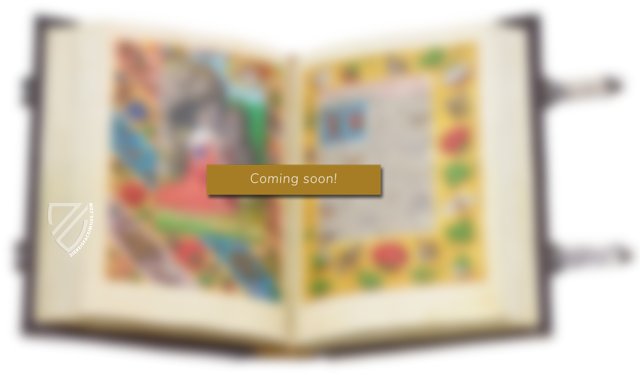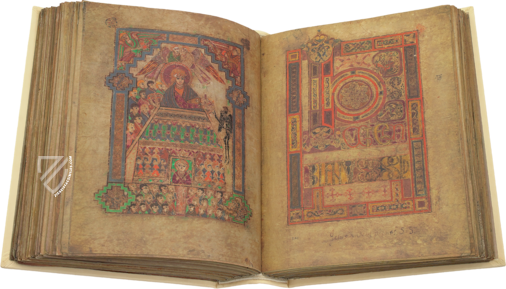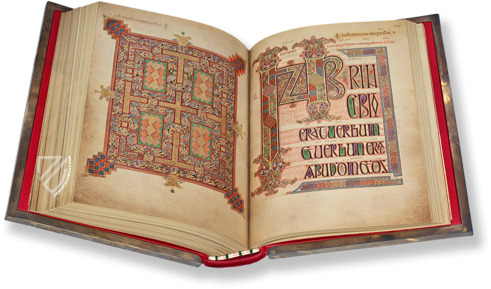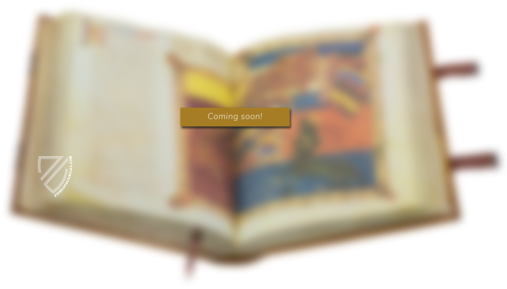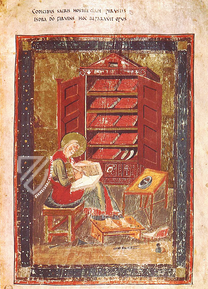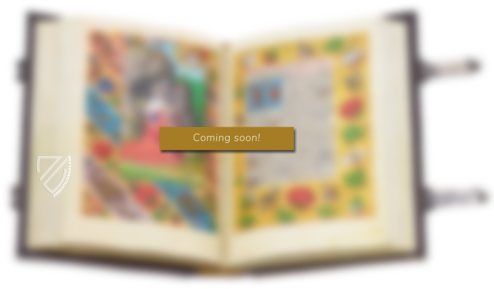Book of Durrow
(1,000€ - 3,000€)
Renowned for the beauty of its illumination, the Book of Durrow is one of the oldest and most important Western European Gospel Books and represents the oldest complete specimen of an Insular Gospel Book, predating the Book of Kells by more than a century. It remains a source of controversy among scholars, who have never definitively agreed on the origins of the codex itself or of the artistic influences found among its six extant carpet pages, a full-page miniature of the four Evangelists' symbols, four full-page miniatures of the individual Evangelist symbols, and six pages with large, elaborate initials and incipits as well as numerous smaller decorative initials. However, it is generally agreed that it was created ca. 700 and perhaps as early as 650, in or near Durrow in County Offaly, Ireland. Badly damaged from centuries of use and occasional misuse, the manuscript has been repaired and rebound numerous times during its 1,300-year lifespan.
Book of Durrow
The Book of Durrow is believed to have emerged in the late-7th century, making it one of the earliest extant Insular manuscripts and a prized relic of early Christian book art. It is highly prized for both its text, which consists of an Irish adaptation of Vulgate Latin, and its art, which is both indicative of Hiberno-Saxon art as well as numerous other traditions. Analysis of the manuscript indicates that it may have served as an exemplar for the scribes who created the Book of Kells. The manuscript continued to be used regularly 500 years after its creation when a passage (Acts 2:1-4) typically read at Pentecost during that period was added to a blank page. It was badly misused in the 17th century when an ignorant farmer immersed a section of the manuscript in water in an attempt to create holy water that he could use to cure his cows. Despite 1,300+ years of wear and tear, the manuscript has managed to survive intact and is an Irish national treasure.
From Durrow Abbey to Trinity College
The Gospel Book is named after the monastery of the same name that was founded by St. Columba, also known as Colum Cille, in County Offaly, Ireland during the late 6th century. Durrow Abbey was an important center of culture and trade where local kings were buried. Although it cannot be stated with certainty whether the manuscript first originated at Durrow Abbey, historical records indicate that it was there by the year 916 and certainly by the late-11th century, when an agreement transferring land from Killeshin Monastery to Durrow was recorded on an empty page in the back of the manuscript. There it remained until the abbey’s dissolution during the 16th century, when it passed into private hands.
It is also known that during the early-10th century the High King of Ireland, Flann Sinna (847–926), commissioned a lost silver-plated cumdach, an elaborate Irish reliquary box for housing a precious book, which in this case also included a relic of St. Columba. In 1661, the Book of Durrow was later donated along with the Book of Kells to Trinity College in Dublin by Henry Jones (ca. 1605–81), the Anglican Bishop of Meath and a vice-chancellor of the College. It remains one of the most prized and prestigious specimens housed in the Trinity College Library today.
A Complex Mix of Artistic Influences
Aside from the origins of the manuscript, scholars intensely debate what artistic styles can be found in the manuscript and there is evidence of influence from various periods and regions. The interlocking spirals and swirls of many initials in the manuscript can be traced to the La Tène style of pre-Christian Celtic art from the Iron Age as well as Pictish stones while the abstract animal décor appears to be inspired by early-7th century Anglo-Saxon metalwork. Meanwhile, Norwegian influences are exhibited in the only human figure found in the manuscript, the Evangelist Symbol for Matthew. There are similarities to Coptic and Syriac manuscripts in the intertwined ribbons and mesh-like designs on some pages as well, indicating that at least one of the artists had travelled to the Eastern Mediterranean.
Unlike most early Irish manuscripts, of the Book of Durrow follows the interpretation of the Evangelist Symbols proposed by St. Ireneus: Matthew – man; Mark – eagle; Luke – ox/calf; John – lion. Their rigid geometric form reveals that rather than being drawn freehand, they were created using drafting tools such as a pair of compasses. Non-invasive testing using micro-Raman spectroscopy and x-ray fluorescence has revealed that the red pigment was created from red lead, the yellow from orpiment, green from copper acetate, and the black and brown inks from iron gall.
Codicology
- Alternative Titles
- Evangeliorum quattuor Codex Durmachensis
Buch von Durrow
Codex Durmachensis
Leabhar Dharú - Size / Format
- 248 folios / 24.5 × 14.5 cm
- Origin
- United Kingdom
- Date
- Ca. 650–700
- Epochs
- Style
- Genre
- Language
- Script
- Insular Half Uncial
- Illustrations
- 11 full-page miniatures (5 pages with the evangelist symbols, 6 carpet pages); 6 text pages with decorative elements
- Content
- The four Gospels with introductory texts and canon tables
- Artist / School
- Attributed to Colum Cille (Columba) (scribe)
- Previous Owners
- Durrow Abbey
Henry Jones
#1 Evangeliorum quattuor Codex Durmachensis
Language: English
(1,000€ - 3,000€)
- Treatises / Secular Books
- Apocalypses / Beatus
- Astronomy / Astrology
- Bestiaries
- Bibles / Gospels
- Chronicles / History / Law
- Geography / Maps
- Saints' Lives
- Islam / Oriental
- Judaism / Hebrew
- Single Leaf Collections
- Leonardo da Vinci
- Literature / Poetry
- Liturgical Manuscripts
- Medicine / Botany / Alchemy
- Music
- Mythology / Prophecies
- Psalters
- Other Religious Books
- Games / Hunting
- Private Devotion Books
- Other Genres
- Afghanistan
- Armenia
- Austria
- Belgium
- Belize
- Bosnia and Herzegovina
- China
- Colombia
- Costa Rica
- Croatia
- Cyprus
- Czech Republic
- Denmark
- Egypt
- El Salvador
- Ethiopia
- France
- Germany
- Greece
- Guatemala
- Honduras
- Hungary
- India
- Iran
- Iraq
- Israel
- Italy
- Japan
- Jordan
- Kazakhstan
- Kyrgyzstan
- Lebanon
- Liechtenstein
- Luxembourg
- Mexico
- Morocco
- Netherlands
- Palestine
- Panama
- Peru
- Poland
- Portugal
- Romania
- Russia
- Serbia
- Spain
- Sri Lanka
- Sweden
- Switzerland
- Syria
- Tajikistan
- Turkey
- Turkmenistan
- Ukraine
- United Kingdom
- United States
- Uzbekistan
- Vatican City
- A. Oosthoek, van Holkema & Warendorf
- Aboca Museum
- Ajuntament de Valencia
- Akademie Verlag
- Akademische Druck- u. Verlagsanstalt (ADEVA)
- Aldo Ausilio Editore - Bottega d’Erasmo
- Alecto Historical Editions
- Alkuin Verlag
- Almqvist & Wiksell
- Amilcare Pizzi
- Andreas & Andreas Verlagsbuchhandlung
- Archa 90
- Archiv Verlag
- Archivi Edizioni
- Arnold Verlag
- ARS
- Ars Magna
- ArtCodex
- AyN Ediciones
- Azimuth Editions
- Badenia Verlag
- Bärenreiter-Verlag
- Belser Verlag
- Belser Verlag / WK Wertkontor
- Benziger Verlag
- Bernardinum Wydawnictwo
- BiblioGemma
- Biblioteca Apostolica Vaticana (Vaticanstadt, Vaticanstadt)
- Bibliotheca Palatina Faksimile Verlag
- Bibliotheca Rara
- Boydell & Brewer
- Bramante Edizioni
- Bredius Genootschap
- Brepols Publishers
- British Library
- C. Weckesser
- Caixa Catalunya
- Canesi
- CAPSA, Ars Scriptoria
- Caratzas Brothers, Publishers
- Carus Verlag
- Casamassima Libri
- Centrum Cartographie Verlag GmbH
- Chavane Verlag
- Christian Brandstätter Verlag
- Circulo Cientifico
- Club Bibliófilo Versol
- Club du Livre
- CM Editores
- Collegium Graphicum
- Collezione Apocrifa Da Vinci
- Comissão Nacional para as Comemorações dos Descobrimentos Portugueses
- Coron Verlag
- Corvina
- CTHS
- D. S. Brewer
- Damon
- De Agostini/UTET
- De Nederlandsche Boekhandel
- De Schutter
- Deuschle & Stemmle
- Deutscher Verlag für Kunstwissenschaft
- DIAMM
- Droz
- E. Schreiber Graphische Kunstanstalten
- Ediciones Boreal
- Ediciones Grial
- Ediclube
- Edições Inapa
- Edilan
- Editalia
- Edition Deuschle
- Edition Georg Popp
- Edition Leipzig
- Edition Libri Illustri
- Editiones Reales Sitios S. L.
- Éditions de l'Oiseau Lyre
- Editions Medicina Rara
- Editorial Casariego
- Editorial Mintzoa
- Editrice Antenore
- Editrice Velar
- Edizioni Edison
- Egeria, S.L.
- Eikon Editores
- Electa
- Emery Walker Limited
- Enciclopèdia Catalana
- Eos-Verlag
- Ephesus Publishing
- Ernst Battenberg
- Eugrammia Press
- Extraordinary Editions
- Fackelverlag
- Facsimila Art & Edition
- Facsimile Editions Ltd.
- Facsimilia Art & Edition Ebert KG
- Faksimile Verlag
- Feuermann Verlag
- Folger Shakespeare Library
- Franco Cosimo Panini Editore
- Friedrich Wittig Verlag
- Fundación Hullera Vasco-Leonesa
- G. Braziller
- Gabriele Mazzotta Editore
- Gebr. Mann Verlag
- Gesellschaft für graphische Industrie
- Getty Research Institute
- Giovanni Domenico de Rossi
- Giunti Editore
- Graffiti
- Grafica European Center of Fine Arts
- Guido Pressler
- Guillermo Blazquez
- Gustav Kiepenheuer
- H. N. Abrams
- Harrassowitz
- Harvard University Press
- Helikon
- Hendrickson Publishers
- Henning Oppermann
- Herder Verlag
- Hes & De Graaf Publishers
- Hoepli
- Holbein-Verlag
- Houghton Library
- Hugo Schmidt Verlag
- Idion Verlag
- Il Bulino, edizioni d'arte
- ILte
- Imago
- Insel Verlag
- Insel-Verlag Anton Kippenberger
- Instituto de Estudios Altoaragoneses
- Instituto Nacional de Antropología e Historia
- Istituto dell'Enciclopedia Italiana - Treccani
- Istituto Ellenico di Studi Bizantini e Postbizantini
- Istituto Geografico De Agostini
- Istituto Poligrafico e Zecca dello Stato
- Italarte Art Establishments
- Jan Thorbecke Verlag
- Johnson Reprint Corporation
- Josef Stocker
- Josef Stocker-Schmid
- Jugoslavija
- Karl W. Hiersemann
- Kasper Straube
- Kaydeda Ediciones
- Kindler Verlag / Coron Verlag
- Kodansha International Ltd.
- Konrad Kölbl Verlag
- Kurt Wolff Verlag
- La Liberia dello Stato
- La Linea Editrice
- La Meta Editore
- Lambert Schneider
- Landeskreditbank Baden-Württemberg
- Leo S. Olschki
- Les Incunables
- Liber Artis
- Library of Congress
- Libreria Musicale Italiana
- Lichtdruck
- Lito Immagine Editore
- Lumen Artis
- Lund Humphries
- M. Moleiro Editor
- Maison des Sciences de l'homme et de la société de Poitiers
- Manuscriptum
- Martinus Nijhoff
- Maruzen-Yushodo Co. Ltd.
- MASA
- Massada Publishers
- McGraw-Hill
- Metropolitan Museum of Art
- Militos
- Millennium Liber
- Müller & Schindler
- Nahar - Stavit
- Nahar and Steimatzky
- National Library of Wales
- Neri Pozza
- Nova Charta
- Oceanum Verlag
- Odeon
- Orbis Mediaevalis
- Orbis Pictus
- Österreichische Staatsdruckerei
- Oxford University Press
- Pageant Books
- Parzellers Buchverlag
- Patrimonio Ediciones
- Pattloch Verlag
- PIAF
- Pieper Verlag
- Plon-Nourrit et cie
- Poligrafiche Bolis
- Presses Universitaires de Strasbourg
- Prestel Verlag
- Princeton University Press
- Prisma Verlag
- Priuli & Verlucca, editori
- Pro Sport Verlag
- Propyläen Verlag
- Pytheas Books
- Quaternio Verlag Luzern
- Reales Sitios
- Recht-Verlag
- Reichert Verlag
- Reichsdruckerei
- Reprint Verlag
- Riehn & Reusch
- Roberto Vattori Editore
- Rosenkilde and Bagger
- Roxburghe Club
- Salerno Editrice
- Saltellus Press
- Sandoz
- Sarajevo Svjetlost
- Schöck ArtPrint Kft.
- Schulsinger Brothers
- Scolar Press
- Scrinium
- Scripta Maneant
- Scriptorium
- Shazar
- Siloé, arte y bibliofilia
- SISMEL - Edizioni del Galluzzo
- Sociedad Mexicana de Antropología
- Société des Bibliophiles & Iconophiles de Belgique
- Soncin Publishing
- Sorli Ediciones
- Stainer and Bell
- Studer
- Styria Verlag
- Sumptibus Pragopress
- Szegedi Tudomànyegyetem
- Taberna Libraria
- Tarshish Books
- Taschen
- Tempus Libri
- Testimonio Compañía Editorial
- Thames and Hudson
- The Clear Vue Publishing Partnership Limited
- The Facsimile Codex
- The Folio Society
- The Marquess of Normanby
- The Richard III and Yorkist History Trust
- Tip.Le.Co
- TouchArt
- TREC Publishing House
- TRI Publishing Co.
- Trident Editore
- Tuliba Collection
- Typis Regiae Officinae Polygraphicae
- Union Verlag Berlin
- Universidad de Granada
- University of California Press
- University of Chicago Press
- Urs Graf
- Vallecchi
- Van Wijnen
- VCH, Acta Humaniora
- VDI Verlag
- VEB Deutscher Verlag für Musik
- Verlag Anton Pustet / Andreas Verlag
- Verlag Bibliophile Drucke Josef Stocker
- Verlag der Münchner Drucke
- Verlag für Regionalgeschichte
- Verlag Styria
- Vicent Garcia Editores
- W. Turnowski Ltd.
- W. Turnowsky
- Waanders Printers
- Wiener Mechitharisten-Congregation (Wien, Österreich)
- Wissenschaftliche Buchgesellschaft
- Wissenschaftliche Verlagsgesellschaft
- Wydawnictwo Dolnoslaskie
- Xuntanza Editorial
- Zakład Narodowy
- Zollikofer AG


